
Today, we will be revisiting the Xiaomi 11T series. It first arrived late in 2021. Let's see how it stacks up a few months after its release.
 |
| Still good in 2022? |
As a recap, the Xiaomi 11T has a 6.67-inch FHD+ AMOLED screen with a 120Hz refresh rate. Inside, it features the 6nm 3.0GHz MediaTek Dimensity 1200 Ultra octa-core processor, Mali-G77 MC9 GPU, 8GB LPDDR5 RAM, and 128GB UFS 3.1 storage. It also has a 5,000mAh battery with 67W fast charging via USB-C. It also has a 108MP triple camera setup and a 16MP selfie camera.
On the other hand, the Xiaomi 11T Pro has a large 6.67-inch FHD+ AMOLED display with a 120Hz refresh rate and a max brightness of 1000 nits. Inside is the 5nm Qualcomm Snapdragon 888, Adreno 660, LPDDR5 RAM, UFS 3.1 storage, and a massive 5,000mAh battery with 120W fast charging via USB-C.
For pricing, the Xiaomi 11T originally starts at PHP 21,990 while the Pro version starts at PHP 27,990. Now, the phones start at PHP 19,999 for the 8GB/128GB variant of the 11T while the 11T Pro now starts at PHP 25,999 for the 8GB/256GB version.
Build Quality/Design
 |
| Identical back design |
During its release, the Xiaomi 11T series sported a pretty, eye-catching design.
The Xiaomi 11T and 11T Pro both feature a glasstic back, polycarbonate inner frame, and Gorilla Glass Victus to protect the screen. Both have rectangular camera islands housing a 108MP triple-camera setup. In front are a punch-hole cutout and slim bezels.
 |
| Modern punch-hole screens |
Overall, the Xiaomi 11T series still hold up compared to smartphones at the same price points in terms of its modern, sleek look.
 |
| Slim looking! |
It maintains a stylish yet minimal look with muted branding. The screen is immersive due to the slim bezels and the punch-hole cutout.
Multimedia Experience
 |
| AMOLED screens |
In terms of multimedia experience, the Xiaomi 11T has a large 6.67-inch Gorilla Glass Victus-protected AMOLED screen. It also has a 2400 x 1080, a 120Hz refresh rate, and a 480 touch sampling rate. In addition, it has MEMC technology, HDR10+ support, and a 395 ppi pixel density.
The Xiaomi 11T Pro also has a 6.67-inch AMOLED Gorilla Glass Victus protected panel with a resolution of 2400 x 1080, a 120Hz refresh rate, a 480Hz touch sampling rate, MEMC, HDR10+ support, and 395 ppi pixel density.
High-refresh rate AMOLED screens!
Since these screens are practically the same, let's discuss them as one. The AMOLED panel used is bright and can provide an immersive viewing experience due to its sharp image with lots of details and vibrant colors. Being an AMOLED panel also provides deep blacks as well as a great dynamic range due to the HDR10+ support.
The 120Hz refresh rate also provides a smoother experience in both daily navigation as well as gaming.
Even in 2022, months after the series' release, this can still be considered top-notch for the price. AMOLED screens hold up well against devices of the same price to date and even to some more expensive ones.
In terms of audio, both devices feature Harman/Kardon stereo speakers at the top and bottom of the devices. It is still a bit of a luxury to have stereo speakers in a smartphone even today. To have Harman/Kardon tuned ones are even better. We do miss the 3.5mm headphone jack, but, both devices use Bluetooth 5.2 for wireless audio which is good.
Cameras
 |
| Powerful cameras! |
For photos and videos, the Xiaomi 11T and Xiaomi 11T Pro feature a triple camera setup with a 108MP f/1.75 w/ PDAF + 8MP f/2.2 120-degree ultra-wide-angle + 5MP f/2.4 3-7cm telemacro + dual-tone LED flash. Both also have a 16MP f/2.45 selfie sensor.
Strong camera specs and robust features!
For the software side, the phones feature modes like Pro, Video, Photo, Portrait, Night mode, 108MP mode, Short Video, Panorama, Documents, VLOG mode, Slow Motion, Time-lapse, Movie Effects, Long Exposure, Dual Video, and Clone. It also has toggles for AI and HDR mode.
Camera Samples
 |
| Daylight 11T |
 |
| Daylight ultra-wide 11T |
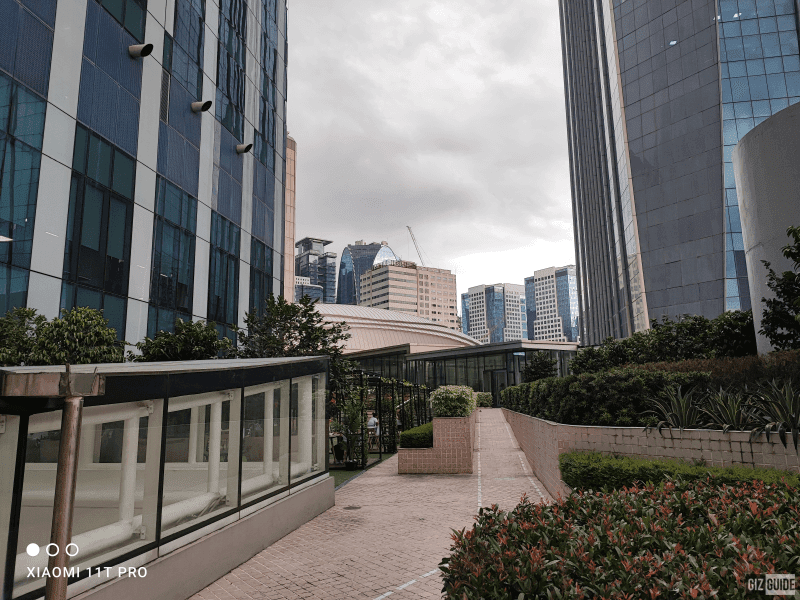 |
| Daylight 11T Pro |
Performance
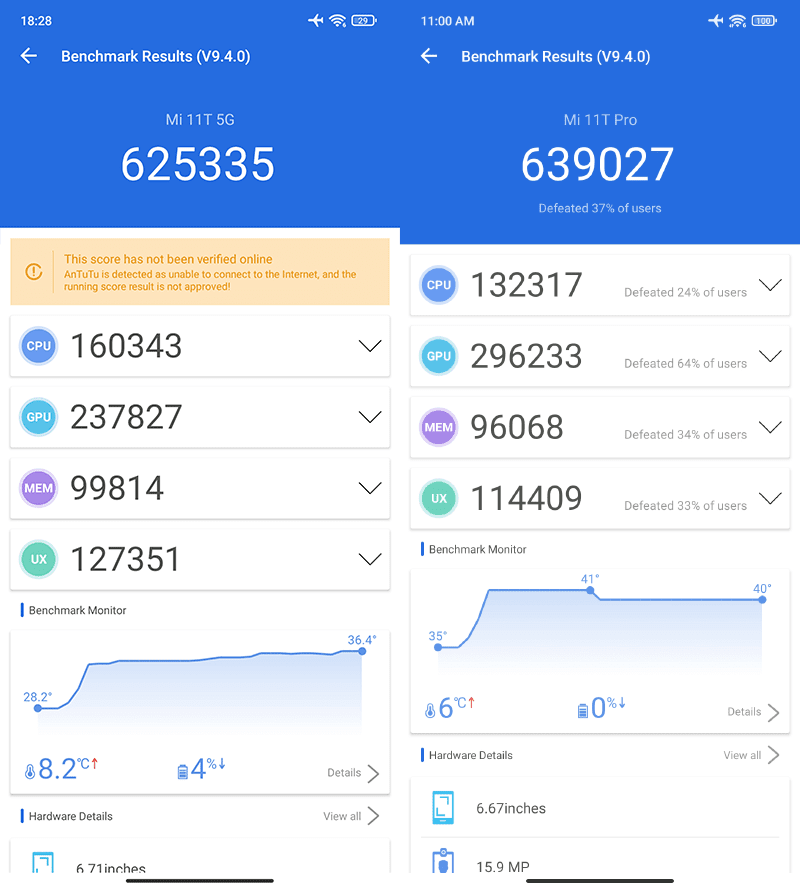 |
| AnTuTu scores of 11T series |
This is where Xiaomi 11T and 11T Pro have a difference. First, the Xiaomi 11T features the 6nm 3.0GHz MediaTek Dimensity 1200 Ultra octa-core processor, Mali-G77 MC9 GPU, 8GB LPDDR5 RAM, and 128GB UFS 3.1 storage. It also has a 5,000mAh battery with 67W fast charging via USB-C.
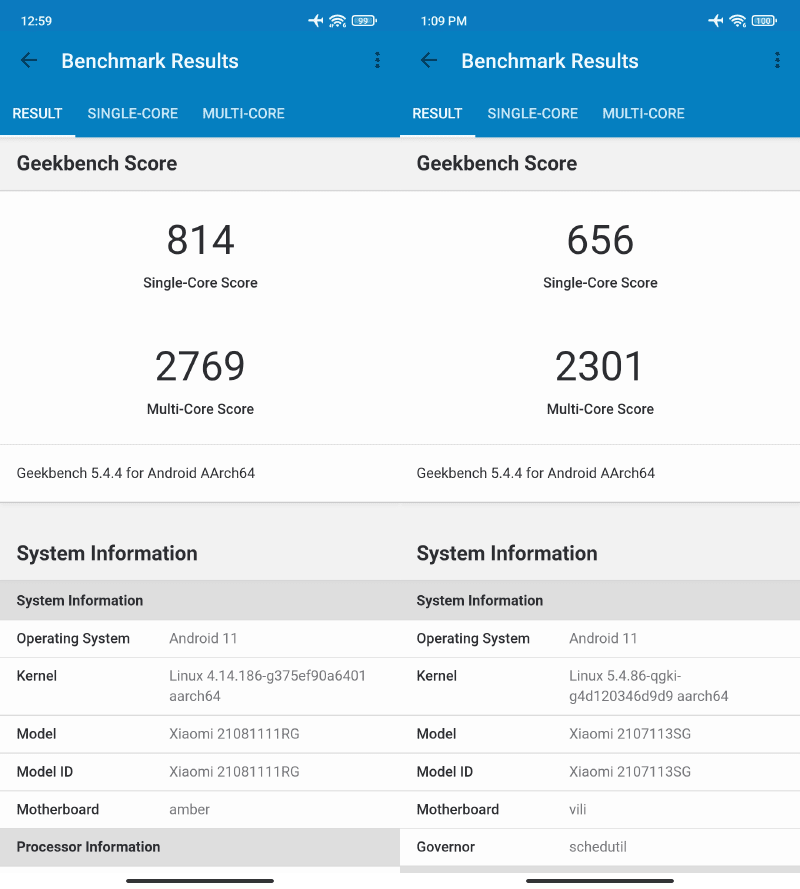 |
| Geekbench scores |
The Xiaomi 11T Pro features the 5nm 2.85GHz Snapdragon 888 octa-core processor, Adreno 660 GPU, up to 12GB LPDDR5 RAM, up to 256GB UFS 3.1 storage, and a 5,000mAh battery with 120W HyperCharge.
Both of these are high-performance specs, especially for the price. Both can run nearly all of the apps you can throw at them with no problem.
 |
| Battery life test |
Both devices also later around 10 to 12 hours in our battery benchmarks during our review. But now, we recorded 13 to 14 hours.
 |
| Fast chargers! |
Both the 67W fast charging and 120W HyperCharge technologies can also replenish the battery quickly.
Xiaomi 11T benchmark scores:
1. AnTuTu - 625,335
2. Geekbench - 814 (single-core), 2,769 (multicore)
3. PC Mark Work 3.0 - 11,957
4. 3D Mark - 4,145 points, average 24.8 fps
5. CPDT - 561.23 (Sequential write speed), 972 (sequential read speed)
6. AI benchmark - 153.9K
Xiaomi 11T Pro benchmark scores:
1. AnTuTu - 639,027
2. Geekbench - 656 (single-core), 2,301 (multicore)
3. PC Mark Work 3.0 - 12,137
4. 3D Mark - 5,506 points, average 33 fps
5. CPDT - 561.23 (Sequential write speed), 972 (sequential read speed)
6. AI benchmark 155.5K
Compared to smartphones released in 2022, both Xiaomi 11T and 11T Pro can definitely compete and even surpass some of them. Multitasking and gaming won't be a problem for both for years to come.
Both also have the latest in connectivity such as WiFi 6 and multiple 5G bands.
Our thoughts
 |
| Still awesome in 2022! |
For us, the Xiaomi 11T and 11T Pro are still two of the best choices at this price point, especially after getting price cuts.
Both feature a sleek design, stunning 120Hz AMOLED screen, near-flagship specs even in 2022, huge battery, up to 120W HyperCharge, 108MP triple camera setup, and 5G connectivity. These are still specs and features that can beat a lot of smartphones in the same price range and even some more expensive ones.
Here are the new price tags for these Xiaomi devices:
Xiaomi 11T 8GB/128GB - PHP 21,999 (PHP 19,999 sale price)
Xiaomi 11T 8GB/256GB - PHP 24,999 (PHP 22,999 sale price)
Xiaomi 11T Pro 8GB/256GB - PHP 27,999 (PHP 25,999 sale price)
Xiaomi 11T Pro 12GB/256GB - PHP 29,999 (PHP 27,999 sale price)
In general, if you're eyeing a new smartphone under PHP 30K, the Xiaomi 11T series gets a stamp of approval from GIZGUIDE.
By the way, those who are interested may get the devices here:












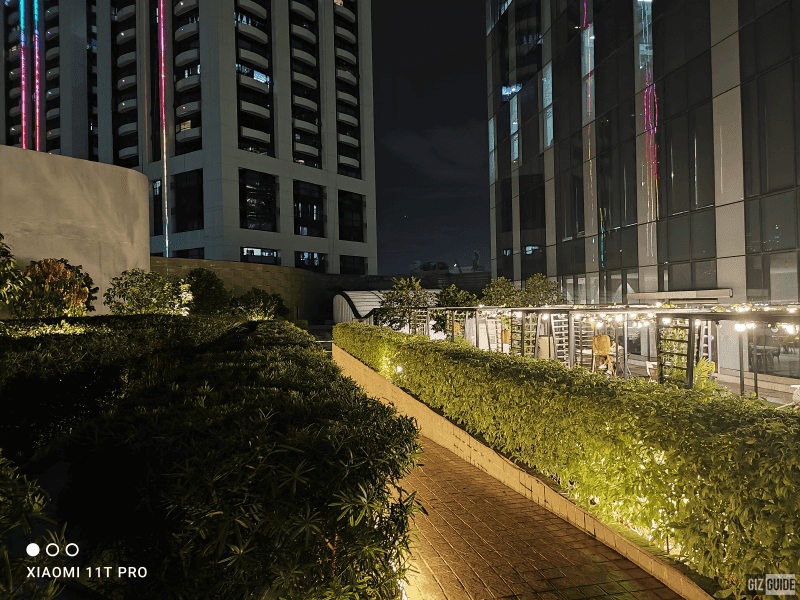
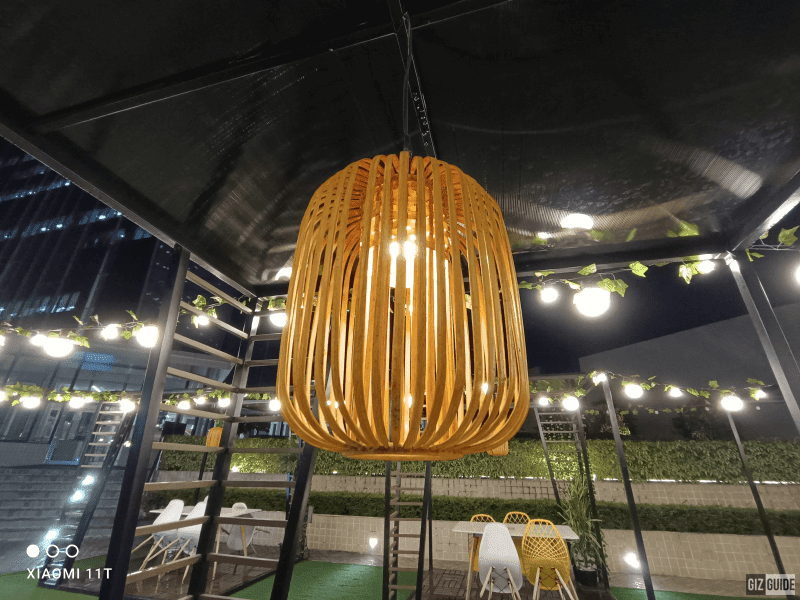

































Post a Comment